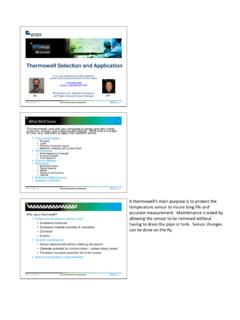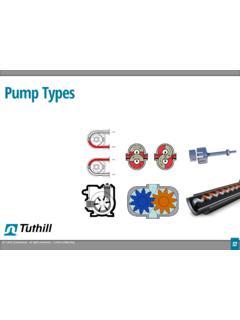Transcription of APPLICATION OF ANTIFOULING SURFACES IN …
1 APPLICATION OF ANTIFOULING SURFACES IN PLATE HEAT EXCHANGER FOR food PRODUCTION A. Bani Kananeh1, E. Scharnbeck1 and D. Hartmann2 1 GEA Ecoflex GmbH, Karl-Schiller-Str. 1-3, D-31157 Sarstedt, Germany, E-mail: 2 Institut f r Umweltverfahrenstechnik IUV, Universit t Bremen, Leobener Str., D-28359 Bremen, Germany ABSTRACT Anti-fouling coatings based on nano-composites have been used to decrease fouling inside plate and frame heat exchanger for food production. The low-energy- SURFACES led to a hydrophobic and oleo-phobic effect. Laboratory and pilot installations were specially developed for the thermal treatment of milk and juices. Four different coated plates were equipped in the heating section of a pasteurizer. The pasteurizer was operated with a 10% whey protein solution which was heated up to 85 C.
2 Significant differences were observed between coated and uncoated plates. Three coatings showed a reduced fouling behavior in comparison with the uncoated stainless steel plates. The electro-polished plates showed also a lower fouling behavior in comparison to the standard stainless steel plates and were almost comparable to the coated plates. The cleaning in place (CIP) time of all coated plates was reduced. INTRODUCTION In food industry, production problems arise mainly as a result of the wall adhesion residue from the perspective of production time and cleaning procedure. The deposits should be eliminated by regular and intensive cleaning procedures in order to be in adequate with the hygiene and quality regulations for food industry, Augustin et. al. (2007). The deposits can also greatly affect the actual production.
3 They are normally formed through the thermal treatment deposits on the heat exchanger SURFACES of heating and vaporization in the dairy and beverage production, which deteriorate the heat transfer and increase the pressure drop. Energy losses and cleaning expenses cause immense costs, Beuf et. al. (2003). Different adhesion mechanisms exist for the different deposits and their adhesion to SURFACES in food industry. The adhesion mechanism is the dominant factor that should be considered in the material development. The adhesion of product on solid SURFACES is mainly determined by the surface roughness and surface energy. In particular, metal SURFACES from stainless steel, as are often used in the food industry; tend to have high surface energies. The adhesion of residues or microbes could be reduced by either decreasing the surface energy of the metal or by the APPLICATION of new coatings with high anti-adhesion effect (low surface energy), like the method of nanotechnology, Gerwann et.
4 Al. (2002). The APPLICATION of the new coatings with high anti-adhesion effect will increase the general hygienic situation and therefore significantly improve the operating efficiency of the food production. Intensity and frequency of cleaning can be substantially reduced to achieve the desired degree of purification, because product deposits and biofouling will be eliminated due to the reduction of adhesive forces, K ck et. al. (2007). In addition to the above economic effects it increases the production process and the production time of the system, thus the production rate in the food processing industry can be improved. PROJECT OBJECTIVES The goal of the project is the APPLICATION of new surface coatings (nanotechnology) to avoid or minimize adhesion, improve process management, simplify cleaning processes with lesser resources and chemical use, and increase the product reliability.
5 It is a great potential of the surface to be useable for the industrial practice of food industry. The APPLICATION shall be applied for the following cases: Deposit formation by the thermal treatment of milk Deposit formation by the pasteurization of fruit juices and vegetables juices The project is therefore based on the APPLICATION and further development of a system of low surface energy coatings with low roughness. EXPERIMENTAL SETUP AND PILOT PLANT For the investigation of product adhesion resulting from heating of milk and juice, heat exchanger facilities in the form of laboratory and pilot scales were constructed. Proceedings of International Conference on Heat Exchanger Fouling and Cleaning VIII - 2009 (Peer-reviewed) June 14-19, 2009, Schladming, Austria Editors: H. M ller-Steinhagen, Malayeri and Watkinson 154 They have the flexibility in terms of hydrodynamic and thermal measurements.
6 Laboratory facility was constructed for the investigation of milk and juice adhesion. A heat exchanger was designed to enable thermal and hydraulic load measurements with variable designs. It consists mainly from a double wall heated receiver tank, controllable pump, electromagnetic flow meter and the test cell. A closed loop was promoted to decrease the volume of the test medium. Furthermore, a fast sample change by simple removal of the test cell was performed. The test channel has cylindrical double-gap geometry, where the inner cylinder is engaged with an electric heater. The coating material is applied to a small stainless steel tube which is pushed inside the heated part. Figure 1 shows the laboratory apparatus used. Fig. 1 Flowchart of laboratory heat exchanger apparatus (Institut f r Umweltverfahrenstechnik IUV, Universit t Bremen).
7 For the experiments, a 10 whey protein solution with water was set in the receiver tank. The pH value was adjusted to using a mol/liter HCl solution. Furthermore, pre-heating is carried out to about 43 C. The solution is pumped in the closed cycle of the experimental setup, the electric heater of the test channel is operated and the measuring procedure is started. After each trial, fresh whey protein solution was replaced to exclude the effect of heating on the ingredients. The experimental parameters are: Average flow velocity: m/s Fluid temperature (measuring section): 44 C Temperature of the heating element : 230 C Heat flux: 20 kW/m Experimental time: 15 to 30 min. The experiments for carrot juice were carried out by the same way for whey protein solution. The carrot juice was placed in the receiver tank with 8 Brix (solution of 12 wt% carrot juice concentrate and water).
8 The preheating temperature in the receiver tank was adjusted to 56 C. The following parameters were adjusted: Average flow velocity: m/s Fluid temperature (measuring section): 55-60 C Temperature of the heating element : 230 C Heat flux: 20 kW/m Experimental time: 10 to 15 min. The fouling resistance (Rf) is calculated from the difference between the overall heat transfer coefficients of the fouled and clean conditions qT60sTqTtTRLiqSurLiqSurf (1) where, Tsur(t): surface temperature of sample after experimental time, t. TLiq : average temperature of solution q : heat flux Practical tests with milk and carrot juice as investigation media were carried out on a small plant by the Institute of food Quality LUFA-Oldenburg, with the support of the company GEA Ecoflex.
9 The pilot plant can produce almost all dairy products. It is used for training purposes as well as technological and procedural support to the food industry. Fig. 2 Pilot plant used for practical tests (Institute of food Quality LUFA-Oldenburg) with GEA Ecoflex VT04 plate heat exchanger. The plate heat exchanger, in which coated and uncoated plates can be installed, has been built so that it could replace the same type existing apparatus. It consists of two cooling sections (deep cooler with 8 plates and pre-cooler with 10 plates), heat recovery section (with 12 plates), heating section (with 7 plates) and hot water section (with 6 plates). Before assembling of the heat exchanger, selected plates for the heating and heat recovery sections were coated by the method of nano-technology.
10 As a reference, stainless steel, electro-polished and PTFE coated plates were also installed in the heat exchanger. Table 1 shows the samples used and their specifications. The milk is pumped from the receiver tank through the pasteurizer with a constant flow rate. In the heating section, the milk can be heated to a maximum temperature of 106 C. The process steps of heating, cooling and heat recovery are combined together. After a working time of four hours, the test is interrupted and the plates of the heater and heat recovery sections are removed in order to denote the deposits formation. Visual observations and mass investigations are done. Furthermore, the cleaning effectiveness is performed. Bani Kananeh et al. / APPLICATION of ANTIFOULING SURFACES .. 1. Samples specifications used in the experiments.






